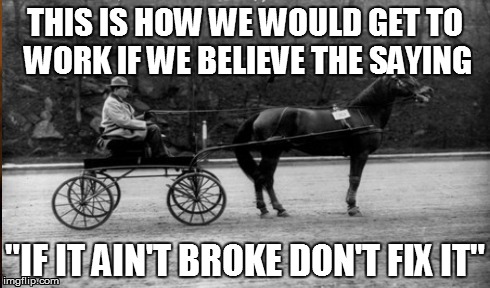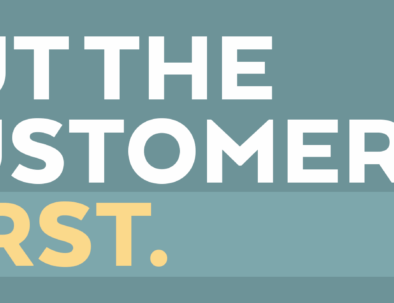In business, there are few phrases that should scare you more than “we’ve always done it this way.”
To be fair, the people who make this comment, or its close cousin, “if it ain’t broke, don’t fix it,” are most often coming from a good place: things are working well, they think, and because we’ve been successful in the past, we should keep repeating the same actions so that we can maintain that success.
While it sounds logical, “we’ve always done it this way” invites complacency and stagnation. It rejects the concept of continuous improvement and acts as a barrier to progress. It frustrates big thinkers and stifles the voices in your company that champion and embrace change. These people are invested in the company and want to see it become more successful. It is the antithesis of moving forward and the definition of standing still.

And when you’re trying to reimagine and transform the way others sell, like we are at ShipEarly with an omni-channel solution for brands to partner online with their dealers, it can stop you cold in your tracks. That’s why I’m finding myself using a different phrase with increasing frequency:
“If it ain’t broke … break it!”
As we challenge our teams to imagine a world vastly different from the present, we must always challenge the old way of doing things, too. Something working adequately should not be the bar for success. Instead, the bar should be whether something works as optimally as it possibly could.
Here’s a concrete example: you have an older way of selling that got you to where you are and had great success 10 years ago. Likely you are continuing to sell the same way, albeit perhaps not as effectively as you used to, so if it ain’t broke… well, you know the rest. But what if that same sales process spawned all sorts of inefficient internal processes over the past decade, and what if the resources your company has to spend on its upkeep are stopping sales innovation and making you less competitive? Or even worse opening opportunities for new entrants to take market share from you who are more responsive to your customers needs.
Is the Steep Price for Preserving the Status Quo Worth Paying?
Asking such questions may sound easy, but it rarely is – especially when a way of doing things is firmly entrenched inside an organization. In our case, we ask manufacturers if they want to increase sales by helping their dealer network sell more. Typically the answer is yes, but when presenting a new path forward, even if it is a win-win, there is reluctance to proceed. The biggest lesson we have learned over the past decade, in retail especially, is if you aren’t disrupting yourself and others, someone else will do it for you. Staying stationary in your tactics is now a losing proposition.
Many organizations have built their business to sell in one way, and have become inflexible to think or implement new ways they could be doing better. I get it, change is uncomfortable but so is slipping into the oblivion and becoming irrelevant as consumer behaviour changes and your caught with no ability or runway to invest. I started asking a few basic questions because I wanted to understand why organizations are not interested in even learning how they can do better.
“This is a distraction, we’ve always sold this way. Why do you keep bringing this to me, I told you I’m not interested (without learning how it could help in the first place).” So the status quo continues and internally within the organization next generation leaders who want to drive innovation and take business forward question if they want to be there.
So What Needs to Change?
Companies and leaders have to embrace a change mentality if they are to be successful in transforming the future to their benefit. This means questioning even the most successful products, projects and initiatives to make room for what works better, at the expense of what has worked well in the past. Big, open-ended questions that require data, context and insight can often be the most helpful: Is this working as well as it could? Why do we do this? Is this the best way to accomplish our goal? In the future what will our customers want?
Those who are willing to challenge the comfortable status quo have the potential to become true champions of change and build a resilient, future-minded and innovative organization. Those who aren’t, risk being left behind.
What Successful Companies Do
Okay, we’ve learned what underperforming companies do, (ie. bury heads in sand not opening themselves to new opportunities and focus on short-term profitability over channel relationships & long-term transformative strategy). Let’s turn our attention to what top performing companies that are outpacing growth do:
1. Commit to the Future
The strategy does not change every week or month. A solid strategy needs time to be executed on. Sales leaders need to anticipate market changes early and turn what could be a threat if they do nothing into an opportunity to capture more market share.
They make trend analysis as part of their sales culture to make sure they are not left behind. Most sales leaders look between one and three years out as opposed to how they can make revenue this month or quarter. Part of that as well means putting their money where their mouth is and investing in new programs at least a year out. Typically at least 6% of their sales budget is spent on items at least a year out.
2. Focus on Digital
Successful brands don’t just “do digital”; they use their full arsenal of capabilities to massively increase the effectiveness of their sales force and to transform the customer buying experience to be “digital first.”
This trend is only becoming more important, as 87% of consumers purchases will involve digital between online research, consideration, or purchase. When it comes to customer experience, leading organizations are building out digital routes to market or augmenting traditional direct or indirect sales with digital.
3. Harnessing of the Full Range of Sales Analytics & Invest in People
Sales leaders are especially strong at harnessing digital tools and capacities to support the entire sales organization. They arm sales teams with digital tools that can quickly deliver relevant and usable insights. Second, they treat partners as an extension of the sales force and invest in collaboration tools to improve the flow of data between organizations. Third, they recognize the potential for big micromarket or macrotrend analyses to improve planning and capture opportunities most effectively.
4. Marriage of Vision with Leadership Action
The vision and insight of where the market is headed is nothing without putting it into action. Top performers set the tone for culture and behavioural thinking to embrace failure and pivot within the strategy. After all, success is a series of failures until you get it right. No sales transformation will work without steadfast support from the very top. Only a committed leader can override internal politics, see the big picture, and focus on the best solution regardless of past practices.





